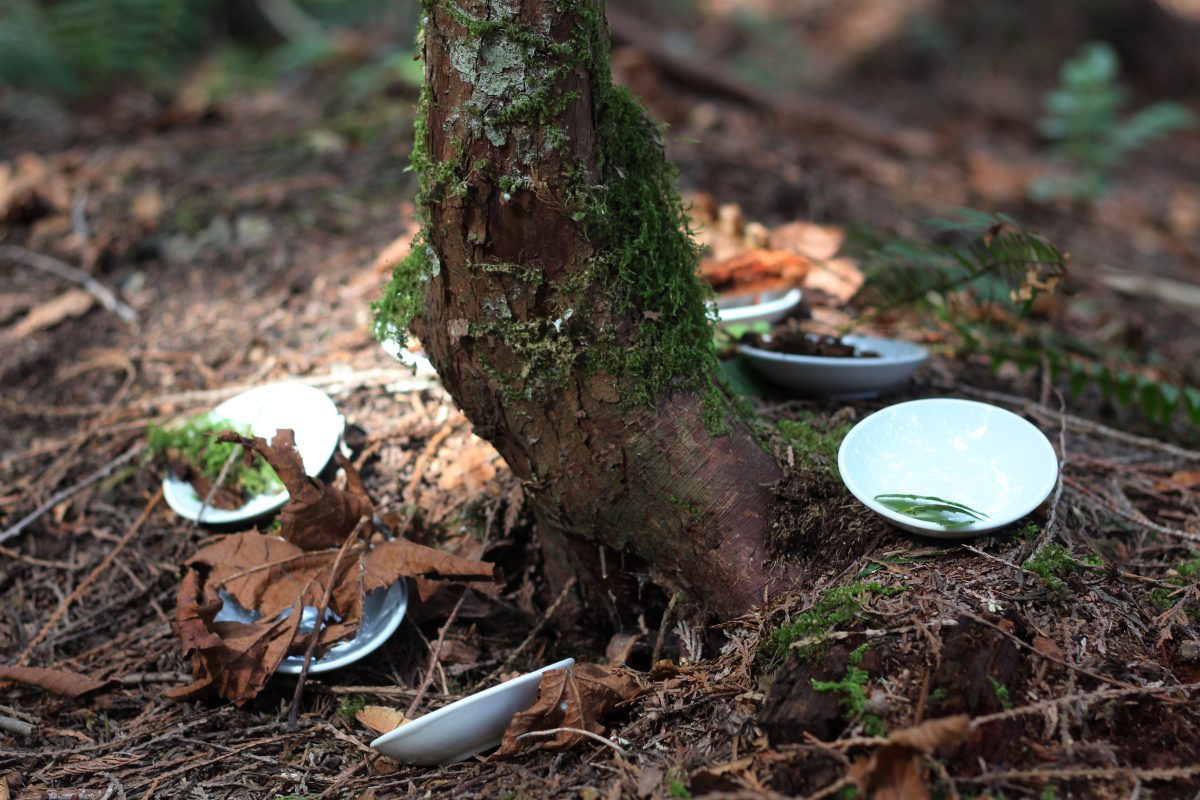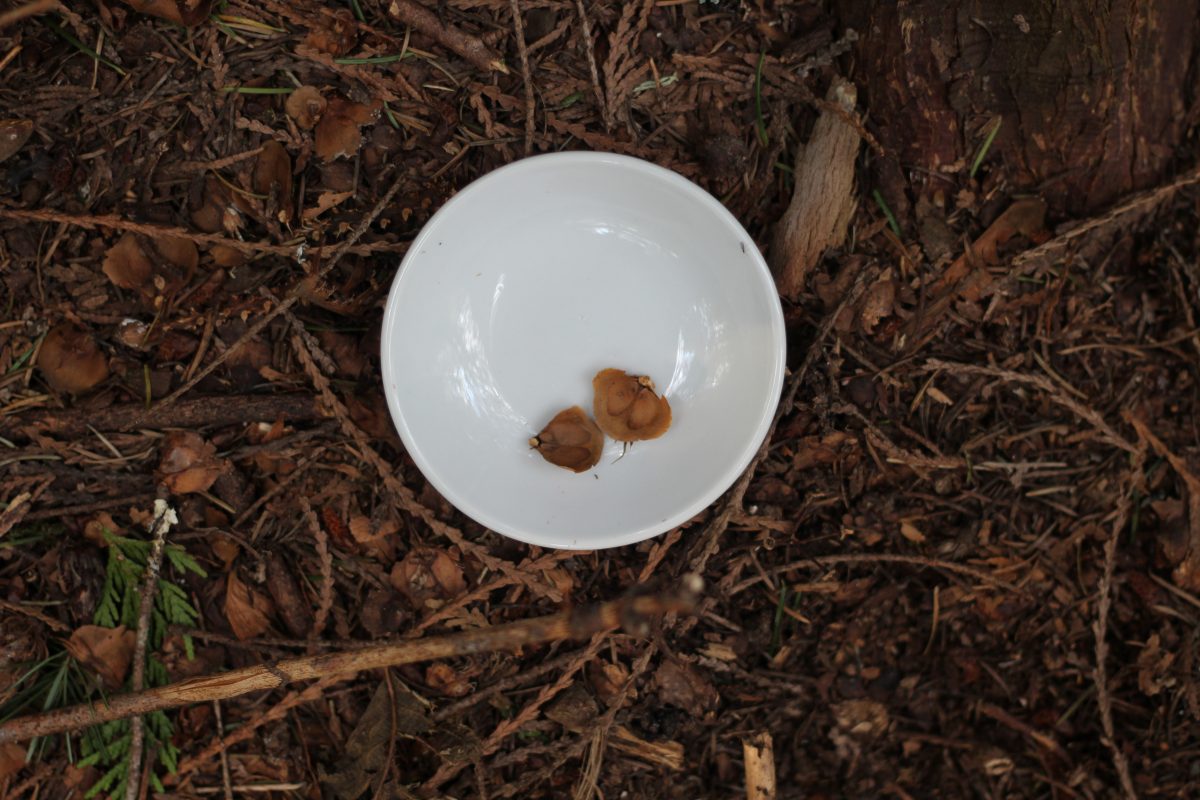
For my workshop, I am exploring the use of natural materiality with children. Because we are focusing on the cedar, it was important for me to go into this process with the concept of co-collaboration with nature versus extracting resources for use from nature. In a timely way, after I had been examining this on my own, I was informed by a reading by Robin Wall Kimmerer, ‘The Serviceberry: An Economy of Abundance’. In this article Kimmerer discusses the shift that can take place when we begin to think of things from nature as gifts rather than resource.

The children’s school is situated on 55 acres of land, and their outdoor play is in a forest. They know this forest well, and I wanted to take this opportunity of learning from them in place-based approach. Did they already have relationships with the trees around them? Were there trees that we more special to them than the rest? If so, could I use these relationships to inform the workshop (and myself) to the natural materials that we would be using?
For me, I wanted to incorporate the act of gifting in a way that fits the age-groups I am working with. I wanted to explore the possibility of a shift in thinking that could take place, and see if the we would start to see the forest around us not as resource, not as plant, but as a non-human living collaborator. In many Indigenous cultures, tobacco is gifted as an act of gratitude when using a plant or animal. But I am not Indigenous, and it is not my role as a settler to pass on this knowledge. Instead, I want to find a way of expressing a similar passage of thought to the kids. Would this simple act of giving change the way a child looks at the chosen tree? Would this shift then be put forward in the workshop with the materials gifted by the cedar tree and used in our workshop of craft and design?

I began the conversation about how in my practice I work with natural materiality and opened the space for the children to share other examples of natural materials. I then talked about how I see these materials (and nature) as a co-designer and that I see the materials I use as gifts, and therefore want to gift back. We then talked about the land, and the trees at the school. Each child then picked a tree that they were grateful for and sat with it.

“Gratitude is so much more than a polite thank you. It is the thread that connects us in a deep relationship, simultaneously physical and spiritual.” Kimmerer (2020)
They were then given ceramics dishes to circle the tree that they had chosen. Once the tree had been circled with these dishes, the children walked through the forest gathering ‘gifts’ for the tree and placed them in each dish. By the end, there were over 200 bowls circling trees, filled with gifts. The older group was then given journals, and they sat with their tree and wrote down why they chose it. The younger group painted a map of their trees, and also sat with their trees while I poured them bowls of tea. At the end we came back together and each group shared our thoughts. The forest was a magical space to walk through after the workshop, and as you walked, you came upon trees circled with gifts.



“I found a tree that has long been special to me. I’ve hidden behind it, I’ve climbed it, etc, etc. Too many people take from nature without paying tribute so I formed bowls around the tree base and put things of nature them to give back rather than take.” – collaborator




I picked this tree because it’s small and I feel like people or things get judged for it. It’s twisty and turny like a mind. It’s still growing so it still has a long life. It has many branches so it could be a good home (for) animals and plants. It’s tall tuching (sp) the sky, that is why I picked it.” -collaborator

Can I design in a way that fosters connection with natural materiality in a collaborative space of gratitude and reciprocity? As I set out to begin this workshop of working with cedar in a variety of ways, it is important to address this question first and foremost. Can doing initial activities such as these inform the children in this way? How can I also develop my practice to honour the ties with our non-human living co-designers?

“When we speak of these not as things or products or commodities, but as gifts, the whole relationship changes.” Kimmerer (2020)

As I said goodbye to the children for the afternoon, as they sprinted away towards parent pick-ups and bicycles, I was left with a space of reflection that surprised me as it caught my breath. Aside from the beautiful moments of reflection, the workshop held also a hectic energy within the tight time frame we had together. We live in a world that moves so fast and children, as they assimilate to this pace we have created for them, seem to be able to move even faster. For me, one of my favourite times of this workshop was the end, when I could wander through the forest, taking photographs and experiencing the creativity that the children had left in their wake. Trees circled with bowls, a pencil forgotten in the woods.

I was joined during this time by one of the children, and it was during this quiet walk, this quality time of simple conversation that I feel a true connection within the workshop was made. We talked about his music, my photography, and the tree that he has picked and why. He led me to another tree, the one that “he knew everyone would go to right away” and about the friendship he has with my daughter. It was in these moments of conversation, that I saw more clearly how connecting with nature can also connect us together. So beautiful, this energy of gratitude and reciprocity, and how it can continue to bounce back and forth, back and forth.

I want to live in a society where the currency of exchange is gratitude and the infinitely renewable resource of kindness, which multiplies every time it is shared rather than depreciating with use. Kimmerer (2020)

